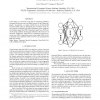Free Online Productivity Tools
i2Speak
i2Symbol
i2OCR
iTex2Img
iWeb2Print
iWeb2Shot
i2Type
iPdf2Split
iPdf2Merge
i2Bopomofo
i2Arabic
i2Style
i2Image
i2PDF
iLatex2Rtf
Sci2ools
ICASSP
2011
IEEE
2011
IEEE
Comparing multilayer perceptron to Deep Belief Network Tandem features for robust ASR
In this paper, we extend the work done on integrating multilayer perceptron (MLP) networks with HMM systems via the Tandem approach. In particular, we explore whether the use of Deep Belief Networks (DBN) adds any substantial gain over MLPs on the Aurora2 speech recognition task under mismatched noise conditions. Our findings suggest that DBNs outperform single layer MLPs under the clean condition, but the gains diminish as the noise level is increased. Furthermore, using MFCCs in conjunction with the posteriors from DBNs outperforms merely using single DBNs in low to moderate noise conditions. MFCCs, however, do not help for the high noise settings.
Deep Belief Networks | ICASSP 2011 | Noise Conditions | Signal Processing | Speech Recognition Task |
| Added | 20 Aug 2011 |
| Updated | 20 Aug 2011 |
| Type | Journal |
| Year | 2011 |
| Where | ICASSP |
| Authors | Oriol Vinyals, Suman V. Ravuri |
Comments (0)

